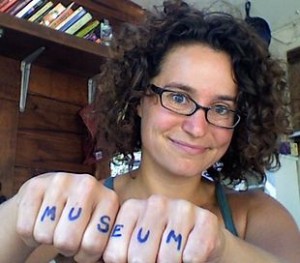
Nina Simon and the Participatory Museum in Ann Arbor, Michigan
This past week, while back at my old graduate school stomping grounds in Ann Arbor, Michigan for the Anthropology and History Program’s Annual Symposium, I reconnected with some of my colleagues in the Museum Studies Program and attended a public talk by Nina Simon, museum consultant and author of the blog Museum 2.0.
Simon confessed to being “obsessed with museums but frustrated.” She doesn’t think they need to change radically, but rather do what they do better. In Simon’s eyes, the answer lies in making museums more visitor-centered, and moving away from the notion that museums’ authority lies in their ability to provide content toward an authority based upon providing platforms for people to do things.
Simon identified three major shifts that need to take place for this to happen. Museums need to change from:
1) destinations & places for everyday use;
2) trusted sources of information & trusted hosts for social experiences
3) places for seeing and exploring & places for making and sharing
Just like Google and the software Web 2.0, Simon wants to create museums that improve as more people use them. This means creating a sense of co-ownership and community, and attracting regular, repeat visitors. It also means offering something fresh and dynamic, particularly for museums that want to bring young people through their doors. Simon is a big fan of late night activities at museums.
Listening to this young, enthusiastic woman, full of hope and ideas for galvanizing a museum revolution, I was inspired by the possibilities for producing more participatory museums. But as I thought more about my own research and that of my affiliated colleagues at CEREV, I realized that the particular challenges of the subject matter with which we are concerned —namely topics relating to and issuing from experiences of violence — complicate and constrain the range of appropriate options in challenging ways.
For such subject matter, there are higher stakes around the question of how to be a safe host. When I asked Simon what advice she had for museum that deal with difficult and painful knowledge, Simon said she hasn’t seen a lot of examples of museums that have found ways to help people share emotional responses to painful issues. While it makes sense that the higher the stakes, the more collaboration and experimentation is required, unfortunately, museums are not traditionally set up to try incremental experiments – although this is precisely what she feels is needed to move forward. (I was pleased to be able to tell her that this exactly what CEREV offers!).
Simon also recommended that when starting a risky project, it is important to identify — and keep returning to — your core mission or goal. The core values needed in curating difficult knowledge are generosity, a commitment to do good, and the sense that there is a real potential to make museums, exhibits, and the world better.
I’ll just end by sharing three goals Nina Simon identified for people engaged in museum work. Regardless of subject matter, they are relevant to all of our projects as educators and public scholars:
-Inspire lifelong learning
-Advance knowledge
-Strengthen our communities
Post by Monica Eileen Patterson



